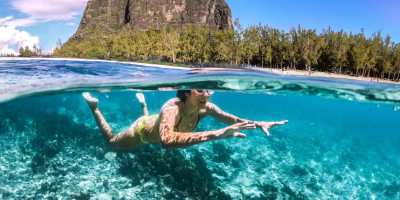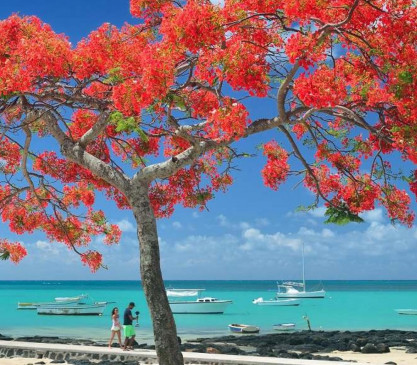
Mauritius
Discovering Mauritius: What to See, What to Do, and Where to Begin
There’s a moment, just after landing in Mauritius, when everything slows down. The horizon shimmers beyond swaying sugarcane fields, the scent of tropical flowers rises from the roadside, and the first glance at the lagoon feels like stepping into a living painting. This is an island where colour, rhythm, and culture meet — not just in the scenery, but in the everyday life of its people.
Mauritius is more than a beach destination — though its calm, reef-fringed waters and stretches of fine sand are undeniably part of the appeal. It’s a place that surprises, with its mix of Creole villages, French-colonial heritage, Hindu temples, and African rhythms. Curious travellers researching a Mauritius travel guide often ask: What are the most authentic things to do in Mauritius? And the answer rarely fits into a checklist.
Whether you’re wandering the bustling streets of Port Louis, hiking through Black River Gorges, or visiting small fishing communities along the southern coast, each experience feels both accessible and unexpected. A good Mauritius itinerary should always include room for detours: a roadside snack stall, a detour to a cliffside viewpoint, or an impromptu swim in a secluded cove.
Nature lovers will be drawn not only to the landscapes, but to the rich wildlife hidden in them. From the giant tortoises of Île aux Aigrettes to the vibrant birdlife in its forests and wetlands, Mauritius is home to species found nowhere else on Earth. The island’s coral reefs also host a spectacular range of marine life, making it one of the top spots for diving in Mauritius and coastal wildlife watching.
Even the most seasoned travellers find themselves rethinking the idea of a tropical holiday here. Beyond its postcard-perfect beaches, Mauritius reveals layers of history, community, and wild beauty that take time — and the right kind of curiosity — to uncover. If you're seeking ideas, start with the Mauritius attractions that blend nature and culture, and let the journey expand from there.
Because no matter how you travel, the most memorable moments in Mauritius often happen far from the obvious — on a quiet beach at sunset, in a forest alive with bird calls, or over a shared conversation on a fishing pier at dusk.


Sailing Routes in Mauritius: A Sea-Level Journey Through Hidden Shores
Mauritius is often imagined from above — a postcard of turquoise lagoons and sandy curves. But the island’s most intimate secrets reveal themselves from the water. Sailing along the coast transforms the landscape: mountains slide into jungle-draped cliffs, shallow coral banks shimmer beneath the hull, and the breeze carries the scent of sugarcane, salt, and spice.
Exploring Mauritius by sea means letting go of the mainland itinerary. Instead of crowded beaches or resort-lined bays, you find quiet coves accessible only by boat, tiny islets perfect for a picnic, and coral gardens waiting just offshore. Mauritius sailing itineraries typically navigate between highlights like Île aux Cerfs, Île aux Benitiers, and the wild south coast — each offering a different rhythm, a different shade of blue.
Catamarans are a popular choice for this kind of travel, ideal for both short Mauritius boat trips and multi-day adventures. IntersailClub offers curated Mauritius catamaran tours that blend comfort with discovery, stopping at the island’s most beautiful and lesser-known anchorages. The pace is slow, by design. From the deck of your Mauritius yacht, you’ll watch flying fish leap at sunrise and listen to the silence of the reef at night.
Many travellers also choose to experience a Mauritius sunset cruise — a serene journey where the sky ignites in colors and the coastline turns to silhouette. Whether you're aboard a spacious catamaran or a sleek yacht in Mauritius, this golden hour at sea becomes one of the most unforgettable parts of the trip.
For those curious about Mauritius island hopping boat tours, the north coast holds surprises too: the low-slung islands of Coin de Mire and Île Plate are reachable by sea and feel a world away from the mainland. Snorkelling spots along the way deliver rich marine life — from butterflyfish to reef sharks — while dolphins often appear in the western lagoons.
Is Mauritius good for yacht cruising? Absolutely — not just for the ease of navigation or mild weather, but because the real Mauritius lives on the edge of land and sea. To sail here is not just to travel — it’s to shift perspective entirely.

Traces of the Past: Culture and History Along the Shores of Mauritius
The history of Mauritius is written in layers—each tide having brought with it a different story. The island’s early presence on Arab maps, followed by the discovery of Mauritius by Portuguese sailors in the 16th century, marked the beginning of centuries of shifting influence. Dutch, French, and British colonizers each left their imprint: in the architecture of Port Louis, in the place names that dot the coast, and in the languages spoken in daily life.
What makes Mauritius truly unique is the way these influences blended, not erased. You’ll find French colonial houses next to bustling markets selling Indian snacks, and maritime towns where the rhythms of sega music drift over the docks. Coastal settlements like Mahébourg preserve their character not only through architecture but through the stories passed on by fishermen, artisans, and cooks.
The Mauritius archives in Port Louis offer a more formal gateway into the past, with records that detail centuries of seafaring, trade, and everyday life under foreign rule. But even outside the official records, history is lived here—through food traditions like smoked marlin or gateaux piments, through handmade crafts, and through the boatbuilders who still work with wood like their ancestors did.
Along the coast, time feels layered. The quiet bays, the weathered piers, and the preserved buildings tell tales of the island’s transformation—from a strategic colony to a thriving, independent nation. The discovery of Mauritius might have been accidental, but the sense of identity shaped by those who stayed—fishermen, traders, sailors, families—feels intentional and deeply rooted in place.
To understand Mauritius, it helps to follow its shorelines. That’s where it's soul resides—in the convergence of culture and coastline, in the subtle traces left by time and tide.
Understanding the Seasons: Mauritius Weather for a Sailing Trip
June is the hottest month in Havana with an average temperature of 27°C (81°F) and the coldest is January at 21°C (70°F) with the most daily sunshine hours at 11 in July. The wettest month is June with an average of 80mm of rain. The best month to swim in the sea is in August when the average sea temperature is 30°C (86°F).
Check all Statistics in Accuweather






